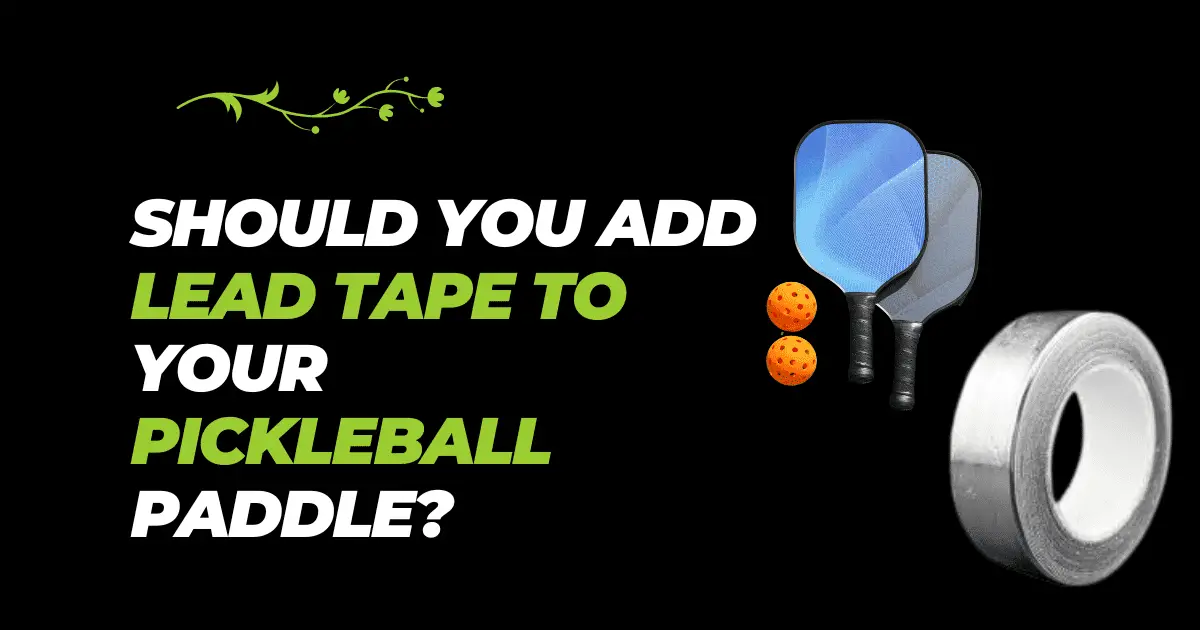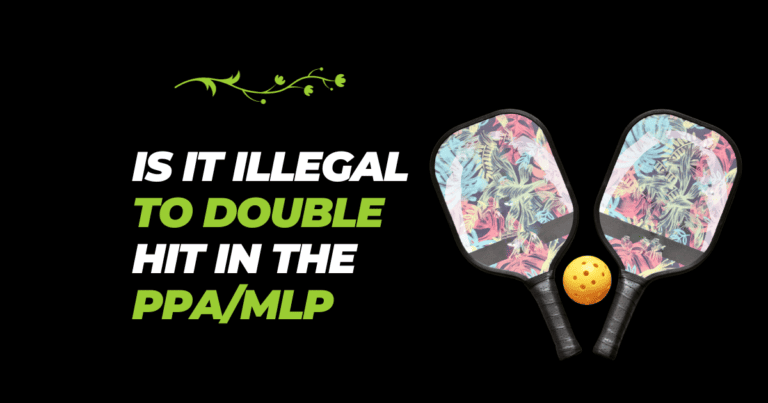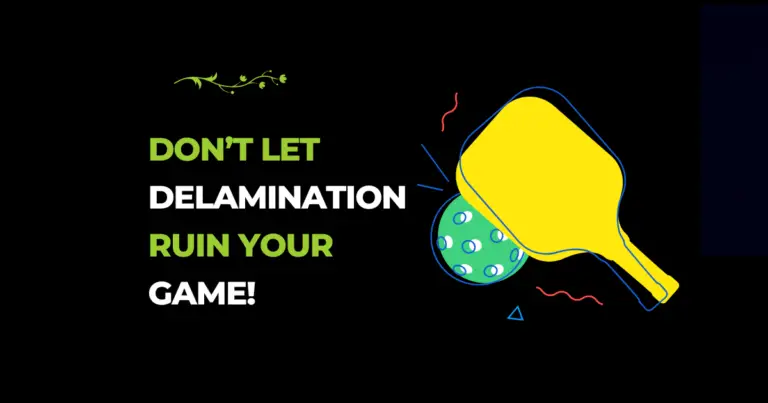Last updated on: September 20, 2025
Should you add lead tape to your pickleball paddle? 🤔 That’s the big question! Some say it helps add power and control. Others argue it throws off your game. Let’s break it down point-by-point to see if lead tape is a 👍 or 👎 for your pickleball skills.
We’ll go through the pros and cons of taping up your paddle so you can enjoy the increased power and control or realize it’s just extra baggage holding you back from dill-icious shots. Don’t get yourself into a pickle – read this article and you’ll soon be on your way to paddle perfection!
What is Lead Tape?
You can skip this part if you know about what lead tape is 😀
Lead tape is a removable, weighted tape that can be applied to certain parts of a paddle. It typically comes in rolls that are 1/2 inch wide. The tape has adhesive on one side so it can stick to the paddle surface. On the other side is a layer of lead that provides additional weight. Lead tape allows players to customize the weight distribution of their paddles. It’s commonly used in racket sports like tennis and racquetball.
Should You Add Lead Tape To Your Pickleball Paddle:
Let’s have a look at adding lead tape to your pickleball paddle pros and cons;
Pros of Adding Lead Tape
Here are some of the potential benefits of adding lead tape to your pickleball paddle:
- Increases paddle head weight – More weight at the head of the paddle means more power and stability. Even just a few strips of lead tape can add 1-3 ounces of weight.
- Improves balance – Strategically placing lead tape at specific points on the paddle can help balance out any uneven weight distribution. This can lead to better control.
- Absorbs vibration – The lead in the tape helps dampen vibration and limit sting on off-center hits.
- Easy to apply and adjust – Lead tape is easy to stick on and remove as needed to tweak the weight and balance. No permanent modifications are required.
- Inexpensive way to customize paddle – A roll of lead tape costs just a few dollars. It’s a budget friendly way to fine tune your paddle compared to buying a new upgraded paddle.
- ** Provides stability for blocks and resets** – The extra weight can make it easier to hold your position on defensive shots and resets at the non-volley zone line.
Cons of Using Lead Tape
However, there are also some downsides to be aware of when adding lead tape to a pickleball paddle:
- Alters feel and touch – Extra weight affects the maneuverability and touch shots. It may take time to adjust your game.
- More stress on arm – The additional weight could increase strain on your arm, elbow, and shoulder over time. This could increase risk of repetitive stress injuries.
- Only marginally legal – Technically lead tape is legal, but heavy addition of weight may exceed guidelines and face scrutiny in regulated tournament play.
- Can move and peel off – Lead tape adhesive can give way over time, especially with heavy use and contact. Reapplying and checking tape is required.
- No long term substitute for proper technique – Don’t use lead tape to overcompensate for flaws in your form or technique. It’s better to take lessons and practice proper mechanics.
| Lead Tape Amount | Effect on Paddle | Recommended For |
| 1-2 strips (6-12 in) | Subtle weight increase | Beginners testing feel |
| 3-4 strips (18-24 in) | Noticeable balance change | Intermediate players |
| 5+ strips (30+ in) | Major swingweight alteration | Advanced/competitive players |
| Tape on paddle edge | Adds stability | Blocking and volley shots |
| Tape on upper face | More power | Aggressive driving |
| Tape on lower face | Better control | Finesse shots |
| Tape on throat | Improves plow through | Serving and third shots |
Determining if Lead Tape Is Right For You
Lead tape can be a useful tuning tool for advanced and competitive players looking for every advantage. But it may not be recommended for beginners who are still developing skills and strength. Here are some questions to help determine if lead tape makes sense for your paddle:
- Do you want to adjust the weight balance for more stability but maintain touch and control?
- Is your current paddle too lightweight and vibrating excessively on hits?
- Do you want to add some power to drives and serves without changing paddles?
- Have you already optimized your paddle grip size and shape for your hand?
- Have you tried a weighted paddle without success?
- Are you an experienced player with consistent stroke technique looking for a performance boost?
If you answered yes to most of these questions, lead tape may be worth experimenting with. But don’t use it to compensate for skills that need development first.
Where to Add Lead Tape on a Pickleball Paddle
If you decide to use lead tape, strategic placement is key. Here are some of the best spots to apply it on a pickleball paddle:
- At the 3 and 9 o’clock positions on the paddle face to add stability.
- Along the top edge of the face to increase power on drives and serves.
- In the middle of the upper half of the face for more control on volleys and blocks.
- On the neck or throat area to improve feel and “plow through”.
- Along the outer edges of the handle to add counterweight.
Start with small 3-6 inch strips of lead tape at first. You can always add more if needed. Avoid placing tape in the central hitting sweet spot as this can deaden the sensation.
| Location on Paddle | Potential Benefits | Potential Drawbacks |
| 3 and 9 o’clock on paddle face | Increased stability on shots | Can make paddle feel sluggish if overdone |
| Top edge of paddle face | More power on drives and serves | May reduce control and touch |
| Upper half of paddle face | Improves control on volleys and blocks | Can deaden the paddle responsiveness |
| Paddle neck/throat | Better plow through and feel | Lead tape here is prone to peeling off |
| Outer paddle handle | Counterbalances head-heavy tape | Makes paddle handle heavier |
Tips for Applying Lead Tape
If you do choose to add lead tape to your pickleball paddle after weighing the pros and cons, here are some tips for doing it effectively:
- Start with just a small amount – Add tape incrementally in 1-2 gram strips. You can always add more, but removing it is trickier.
- Place vertically or diagonally – Applying tape vertically or diagonally along the face or neck of the paddle dissipates vibration better than horizontal strips across the face.
- Focus weight towards top half of paddle – Keep extra weight higher up on the paddle to maximize power while maintaining touch and control.
- Balance uneven grip handles – If your paddle handle is heavier on one side, add a counterweight strip of tape on the lighter side to even it out.
- Avoid contact areas – Keep lead tape away from main ball contact zones on paddle face to optimize feel and control.
- Test paddle after applying – Take some practice swings and hits after applying tape to check balance and feel before using in a match.
- Check adhesive frequently – Press down tape firmly initially and check periodically to ensure tape is still secure as adhesive can give way over time.
How Much Lead Tape to Add?
There are no definitive rules on how much lead tape to add to a pickleball paddle. It depends on your current paddle weight, your skill level, your stroke mechanics, and personal preference. Here are some general guidelines:
- Beginner players – 2-4 grams (1-2 strips)
- Intermediate players – 4-8 grams (2-4 strips)
- Advanced players – Up to 12 grams (5-6 strips)
Start conservatively with smaller amounts. You can continue adding tape in increments until you achieve your desired weight and balance. Again, focus on the top half of the paddle and avoid the direct ball strike zone.

Lead Tape Rules for Tournament Play
Most sanctioned pickleball tournaments follow the equipment guidelines set forth by the USA Pickleball Association (USAPA). Here are the key rules regarding lead tape:
- Lead tape is legal but cannot permanently alter or damage the paddle surface.
- Total paddle weight including lead tape cannot exceed 6 ounces.
- The paddle surface must be free of any tape, vinyl, paint or other texture material in the center contact area.
- Lead tape placement and total weight may be subject to scrutiny, especially if it appears excessive.
Make sure you follow all rules for tournaments and organized play. Know that some facilities or groups may prohibit lead tape, so check rules before playing.
Step-By-Step Process for Applying Lead Tape
Follow these steps when putting lead tape on your pickleball paddle:
- Clean the paddle surface thoroughly where tape will be applied. Use isopropyl alcohol on a cloth.
- Decide on lead tape placement based on your needs. Less is more, so start small.
- Cut lead tape strips to the desired lengths using scissors. Round the corners.
- Remove backing paper to expose adhesive surface. Handle carefully to avoid sticking to fingers.
- Apply one end of the lead tape strip to the paddle. Smooth down gently with your thumb as you go.
- Use a soft cloth to firmly press the entire length of the tape onto the paddle. Rub to maximize adhesion.
- If using multiple strips, carefully align them 1/16″ apart to avoid overlap.
- Use a coin or plastic blade to rub the tape edges and prevent peeling.
- Let adhesive cure for 24 hours before playing with the newly weighted paddle.
- Add more tape in small increments if a heavier feel is desired.
Always remove old tape residue completely before applying new strips. Take care not to overdo it with the lead tape additions.
Frequently Asked Questions
Here are answers to some common questions about adding lead tape to pickleball paddles:
Where exactly should I put the lead tape on my paddle?
Focus on the upper half of the paddle – the neck, shoulder, and upper part of the face. Avoid the direct ball strike zone in the center. You can experiment with vertical strips, diagonal cross-hatching, or small blocks.
Does lead tape damage the paddle surface?
It shouldn’t if applied properly. Use care removing tape to avoid pulling off paddle graphics. Avoid textured tape that could imprint on the surface.
How do I get old lead tape residue off my paddle?
Use lighter fluid or Goo Gone adhesive remover wipes to gently dissolve any remaining sticky residue after removing old tape. Wipe clean with a dry cloth.
How long does lead tape last before needing to be replaced?
It varies depending on use, storage, and climate, but expect to replace tape after 4-6 months of frequent play. Check periodically for peeling edges or sections that need reapplying.
Can I reuse lead tape if I remove it?
You can reuse lead tape 1-2 times if carefully removed and stored. The adhesive won’t be as strong though so replace old tape strips after a few reapplications.
Is it cheating to use lead tape in pickleball?
No, up to a point. As long as you follow regulations on weight limits, lead tape provides a legal way to customize your paddle. Just don’t overdo it to compensate for poor form.
How much does lead tape weigh?
The most common lead tape used on paddles is 0.5 mm thick and weighs approximately 6 grams per foot. Multiple strips can quickly add weight.
Does lead tape damage the paddle?
It will not normally damage the face of graphite or fiberglass paddles. But take care removing it to avoid pulling off paddle graphics or layers. Don’t apply to wood paddles due to potential finish issues.
Where can I buy lead tape for pickleball paddles?
Many online retailers like Amazon offer lead tape rolls specifically designed for racquet sports. Some pickleball shops also carry it. Look for 1/2 inch width tape with easy tear perforations.
Is lead tape legal in pickleball tournaments?
Most sanctioned tournaments allow lead tape as long as it complies with size limits and doesn’t exceed 20% of the unaltered paddle weight. But regulations differ, so check specific event rules.
How much lead tape should a beginner use?
Novices should use zero or minimal lead tape as it can become a crutch that inhibits proper technique development. Focus on grip, footwork, positioning and ball contact instead.
Can I put lead tape on paddle edges?
Yes, the perimeter edges are common lead tape placement spots, especially at the 2, 4, 8, and 10 o’clock positions. This adds stability while keeping the sweet spot clear.
What’s better – lead tape or a weighted paddle?
Lead tape offers more customization of weight distribution. But weighted paddles are easier to swing compared to adding lead tape which can impact maneuverability if overdone. Try both to see what feels best for your game.
Get the Most From Lead Tape Customization
Adding lead tape provides ways to fine-tune your paddle’s weight balance and feel. Start slowly and carefully document where you place strips to best match your playing style and needs. While not right for everyone, strategic lead tape application can give that extra advantage to hardcore pickleball competitors. Just don’t overdue it, and focus more on improving skills with practice. Master your paddle and lead tape customizations over time for best results. Now get out on those pickleball courts and make some noise with your leaded-up paddle!
If you’re interested to know the top female pickleball players to watch out for in 2023, this article may be worth exploring.








One Comment